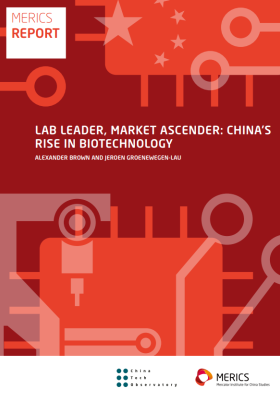

EU-China climate policy – balancing cooperation and pressure
Chinese reactions to EU measures show a largely constructive approach, says Barbara Pongratz. Europe has to build on this momentum and avoid triggering backlashes.
Chinese reactions to three key European climate-policy measures show that the EU is in a position to motivate China to accelerate its climate mitigation efforts. The EU’s Carbon Border Adjustment Mechanism (CBAM), Emissions Trading Scheme (ETS) and its green finance frameworks have sparked co-operative and critical reactions from Chinese commentators in academia and politics. To avoid damaging disputes, the EU has to maintain the right balance between working together with China and putting pressure on it to speed up climate action. With both sides’ combined efforts, it may be possible to more effectively reach the common goal of keeping the global temperature rise below 2.0 degrees Celsius.
Chinese critics say the Carbon Border Adjustment Mechanism is protectionist
Perhaps the most controversial EU measure is the Carbon Border Adjustment Mechanism (CBAM), which from 2023 is meant to impose tariffs on carbon-intensive imports to counter carbon leakage. CBAM can be seen as an instrument of fair competition within the EU – it ensures foreign companies bear the same environmental costs as European competitors. Zhao Lijian from the Carbon Trust China Office says many Chinese stakeholders view CBAM as a trade barrier. Some even regard it a protectionist move. Chinese experts are unsure about the EU’s motivation for CBAM and criticize its scope, design, risks and compatibility with the Paris Agreement and the World Trade Organization. The EU needs to communicate CBAM better.
The EU still has to decide crucial details of the scheme. A recent YouGov-E3G survey shows that the European public is generally in favor of CBAM, regardless of potential obstacles to trade. Experts at Chinese government think tanks have been discussing the possibility of introducing counter-measures should the EU not compromise on critical issues such as the use of revenue, exemptions and a link to Emission Trading Scheme (ETS) reform. A key question about CBAM revenues is whether they will be used for the EU’s own budget or whether they will be earmarked for other climate-change mitigation measures.
Chinese negotiators are pushing for creation of a global carbon market
CBAM is closely related to another important issue in EU-China discussions, the Emission Trading Scheme (ETS). Chinese policymakers want to accelerate development of a Chinese scheme with the EU’s help. The EU ETS is the largest and most advanced emissions trading market. The EU and Germany have been helping China develop its own ETS, a good example of constructive cooperation. Chinese commentators have urged the EU to link CBAM to ETS reform and allow exemptions for China’s developing economy to avoid double burdens for its companies. Chinese negotiators have also ambitiously suggested increasing EU-China cooperation to create a global carbon market as an alternative to Europe’s CBAM.
The EU has set a higher carbon price in its ETS than China and could use it as a benchmark for determining the carbon tax within CBAM, posing a risk for EU-China trade relations. Steel, for example, is not covered by the Chinese ETS and would be included in the current EU CBAM proposal. Chinese commentators criticize this could seriously hurt China’s sizeable steel exports. However, the actual impact of CBAM on trade with the EU is disputed – in recent EU-China discussions, EU stakeholders said CBAM at least initially would not affect trade that much. But the EU’s announcement that it might phase in CBAM for steel and some other sectors in 2023 has put pressure on China to push on with ETS sector coverage.
EU approaches to green finance are praised by Chinese observers
However, the open debate between the EU and China about CBAM and ETS shows the general direction of EU climate action to be cooperative. Indeed, Chinese reactions to EU moves in green finance show a willingness to reciprocate. Chinese observers have praised EU moves to mobilize financing for sustainable growth. They see the EU as a pioneering market for investment guided by environmental, social and governance (ESG) criteria. Bankers and experts praise its sustainable finance classification scheme and other ESG frameworks for being comprehensive and practical – and note that China still has a way to go.
Chen Yulu, deputy governor of the People’s Bank of China (PBOC), is often quoted in the green finance context. In a speech at a green finance forum last year, he called on China to continue promoting green finance and named increased international cooperation as one of three crucial steps to take. This year, a number of government ministries published important new policies about ESG investment. Both sides are stepping up their efforts to devise regulations for green finance, and this suggests that cooperation can also be the name of the game in this context – if it is coordinated well.
China’s drive for more green finance guidance for Chinese companies is not just politically motivated, it is meant to increase EU-China investment flows. Although only 11 percent of Chinese investors consider ESG in practice, China ranks first globally in terms of outstanding green loan value. With its developing green business sector, China can leverage the increased interest in green investment and the EU’s stricter green finance rules. In a Ministry of Commerce-affiliated magazine, Chinese commentators have emphasized that the EU and China “need to add concrete and actionable commitments” and harmonize existing approaches on both sides.
EU measures can motivate moves towards climate action in China
China’s response to the three key European climate-policy measures is striking in that many government-affiliated analysts and experts have called for the accelerated implementation of Chinese measures. This shows that EU measures can motivate China to move towards accelerated climate action. Brussels’ approach of pursuing climate cooperation and applying pressure is proving effective.
Both the EU and China have committed to achieving net zero emissions. The willingness to act and implement climate-action measures exists on both sides. The EU would be well advised to further build on the debate in China and use this momentum for negotiating ambitious but appropriate measures in EU-China climate-policy discussions.
